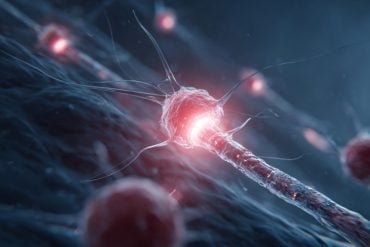Summary: Eating disorder behaviors are reinforced due to changes in the brain’s reward response processes and alterations in the food intake control network.
Source: NIH
Researchers have found that eating disorder behaviors, such as binge-eating, alter the brain’s reward response process and food intake control circuitry, which can reinforce these behaviors. Understanding how eating disorder behaviors and neurobiology interact can shed light on why these disorders often become chronic and could aid in the future development of treatments.
The study, published in JAMA Psychiatry, was supported by the National Institutes of Health.
“This work is significant because it links biological and behavioral factors that interact to adversely impact eating behaviors,” said Janani Prabhakar, Ph.D., of the Division of Translational Research at the National Institute of Mental Health, part of NIH.
“It deepens our knowledge about the underlying biological causes of behavioral symptom presentation related to eating disorders and will give researchers and clinicians better information about how, when, and with whom to intervene.”
Eating disorders are serious mental illnesses that can lead to severe complications, including death. Common eating disorders include anorexia nervosa, bulimia nervosa, and binge-eating disorder. Behaviors associated with eating disorders can vary in type and severity and include actions such as binge-eating, purging, and restricting food intake.
In this study, Guido Frank, M.D., at the University of California San Diego, and colleagues wanted to see how behaviors across the eating disorder spectrum affect reward response in the brain, how changes in reward response alter food intake control circuitry, and if these changes reinforce eating disorder behaviors.
The study enrolled 197 women with different eating disorders (including anorexia nervosa, bulimia nervosa, binge-eating disorder, and other specified feeding and eating disorders) and different body mass indexes (BMIs) associated with eating disorder behaviors, as well as 120 women without eating disorders.
The researchers used cross-sectional functional brain imaging to study brain responses during a taste reward task. During this task, participants received or were denied an unexpected, salient sweet stimulus (a taste of a sugar solution). The researchers analyzed a brain reward response known as “prediction error,” a dopamine-related signaling process that measures the degree of deviation from the expectation, or how surprised a person was receiving the unexpected stimulus.
A higher prediction error indicates that the person was more surprised, while a lower prediction error indicates they were less surprised. They also investigated whether this brain response was associated with ventral-striatal-hypothalamic circuitry, a neural system associated with food intake control.
The researchers found that there was no significant correlation between BMI, eating disorder behavior, and brain reward response in the group of women without eating disorders. In the group of women with eating disorders, higher BMI and binge-eating behaviors were associated with lower prediction error response.

Further, for the women with eating disorders, the direction of ventral striatal-hypothalamic connectivity was the reverse of those without eating disorders, with connectivity directed from the ventral striatum to the hypothalamus. This connectivity was positively related to the prediction error response and negatively related to feeling out of control after eating.
These results suggest that for the women with eating disorders, eating disorder behaviors and excessive weight loss or weight gain modulated the brain’s dopamine-related reward circuit response, altering brain circuitry associated with food intake control, and potentially reinforcing eating disorder behaviors. For example, women with anorexia nervosa, restrictive food intake, and low BMIs had a high prediction error response.
This response may strengthen their food intake-control circuitry, leading these women to be able to override hunger cues. In contrast, the opposite seems to be the case for women with binge-eating episodes and higher BMIs.
“The study provides a model for how behavioral traits promote eating problems and changes in BMI, and how eating disorder behaviors, anxiety, mood, and brain neurobiology interact to reinforce the vicious cycle of eating disorders, making recovery very difficult,” said Dr. Frank.
Overall, this study suggests that behavioral traits, including food intake behavior, contribute to eating disorder maintenance and progression by modulating one’s internal reward response and altering food intake control circuitry. However, further research is needed to investigate treatments that could target and change behaviors for individuals with eating disorders to achieve lasting recovery.
About this eating disorder research news
Source: NIH
Contact: Press Office – NIH
Image: The image is in the public domain
Original Research: Closed access.
“Association of Brain Reward Response With Body Mass Index and Ventral Striatal-Hypothalamic Circuitry Among Young Women With Eating Disorders” by Guido Frank et al. JAMA Psychiatry
Abstract
Association of Brain Reward Response With Body Mass Index and Ventral Striatal-Hypothalamic Circuitry Among Young Women With Eating Disorders
Importance
Eating disorders are severe psychiatric disorders; however, disease models that cross subtypes and integrate behavior and neurobiologic factors are lacking.
Objective
To assess brain response during unexpected receipt or omission of a salient sweet stimulus across a large sample of individuals with eating disorders and healthy controls and test for evidence of whether this brain response is associated with the ventral striatal-hypothalamic circuitry, which has been associated with food intake control, and whether salient stimulus response and eating disorder related behaviors are associated.
Design, Setting, and Participants
In this cross-sectional functional brain imaging study, young adults across the eating disorder spectrum were matched with healthy controls at a university brain imaging facility and eating disorder treatment program. During a sucrose taste classic conditioning paradigm, violations of learned associations between conditioned visual and unconditioned taste stimuli evoked the dopamine-related prediction error. Dynamic effective connectivity during expected sweet taste receipt was studied to investigate hierarchical brain activation between food intake relevant brain regions. The study was conducted from June 2014 to November 2019. Data were analyzed from December 2019 to February 2020.
Main Outcomes and Measures
Prediction error brain reward response across insula and striatum; dynamic effective connectivity between hypothalamus and ventral striatum; and demographic and behavior variables and their correlations with prediction error brain response and connectivity edge coefficients.
Results
Of 317 female participants (197 with eating disorders and 120 healthy controls), the mean (SD) age was 23.8 (5.6) years and mean (SD) body mass index was 20.8 (5.4). Prediction error response was elevated in participants with anorexia nervosa (Wilks λ, 0.843; P = .001) and in participants with eating disorders inversely correlated with body mass index (left nucleus accumbens: r = −0.291; 95% CI, −0.413 to −0.167; P < .001; right dorsal anterior insula: r = −0.228; 95% CI, −0.366 to −0.089; P = .001), eating disorder inventory–3 binge eating tendency (left nucleus accumbens: r = −0.207; 95% CI, −0.333 to −0.073; P = .004; right dorsal anterior insula: r = −0.220; 95% CI, −0.354 to −0.073; P = .002), and trait anxiety (left nucleus accumbens: r = −0.148; 95% CI, −0.288 to −0.003; P = .04; right dorsal anterior insula: r = −0.221; 95% CI, −0.357 to −0.076; P = .002). Ventral striatal to hypothalamus directed connectivity was positively correlated with ventral striatal prediction error in eating disorders (r = 0.189; 95% CI, 0.045-0.324; P = .01) and negatively correlated with feeling out of control after eating (right side: r = –0.328; 95% CI, –0.480 to –0.164; P < .001; left side: r = –0.297; 95% CI, –0.439 to –0.142; P = .001).
Conclusions and Relevance
The results of this cross-sectional imaging study support that body mass index modulates prediction error and food intake control circuitry in the brain. Once altered, this circuitry may reinforce eating disorder behaviors when paired with behavioral traits associated with overeating or undereating.






